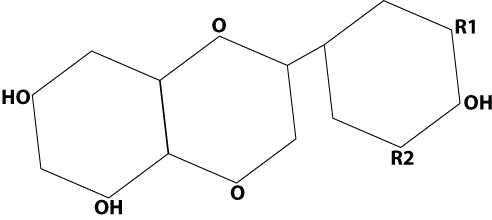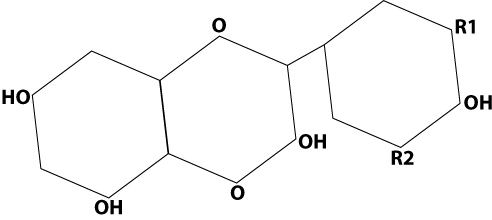There are four classes of pigments providing not only different colours but also fulfilling essential functions:
1) Chlorophyll: This green pigment is essential for the process of photosynthesis, which transforms light energy and carbon dioxide (CO2) to glucose and oxygen (O2). Chlorophyll makes good use of the blue and red portions of the wavelength of light, but is not good in using the green portions: Red und blue light is being absorbed, green light is reflected. Therefore, the parts of the plant which contain chlorophyll, have green colour. Chemically, the pigment molecule consists of a magnesium core with 4 surrounding parts of nitrogen as well as 5 or 6 parts of oxygen, 28 to 72 parts of hydrogen and 35 to 55 parts of carbon. They are not water, but lipid soluble and located in the chloroplasts of the cell. The name’s roots are Greek: χλωρός (chloros is “green”) and φύλλον (phyllon is “leaf”).
2) Flavonoids: These water soluble pigments are based on the amino acid Phenylalanine, which is found in high levels in the breast milk of mammals. There are two different groups of flavonoids:
2 a) Anthocyanins: These pigments provide a broad range of colours from orange/red to violet/blue. The specific colour is determined by other pigments, metal ions and the pH value (they change from change from red in acids to blue in bases) (Yoshikazu Tanaka/Nobuhiro Sasaki/Akemi Ohmiya: Biosynthesis of plant pigments: anthocyanins, betalains and carotenoids. In: The Plant Journal, 54/2008 , p. 733-749). Anthocyanins are most prominent in the petals of flowers – all the albiflora varieties of orchids are missing them. The colour provided by anthocyanins has several biological functions. One of them is to reflect light waves to the chlorophyll regions of the plants to increase the production of glucose. Furthermore, anthocyanins protect sensible parts of the plant from possibly destructive light effects by absorbing blue-green and UV light.
Last but not least the colour of the flower is attracting pollinators. There are probably more than 550 different kinds of anthocyanins. Among them are the brick-red pelargonidin, the red cyanidin and the blue delphinidin pigments.
In a complex process of biosynthesis more than five enzymes are needed to produce the water soluble anthocyanins in the vacuoles of the cell. Any even minor disruption in any of the mechanism of these enzymes by either genetic or environmental factors would halt anthocyanin production (Wikipedia:Anthocyanins). The name is derived from the Greek ἀνθός (anthos is “flower”) and κυανός (kyanos is “blue”).
2 b) Flavones and Flavonols. These flavonoids are called co-pigments, because they are colourless for the human eye, but can influence the colour of anthocyanins. The difference between both is that Flavonols have an additional hydroxyl in their molecular structure. As they absorb UV, which insects recognize, they give colour and patterns to flowers to attract insects (Tanaka/Sasaki/Ohmiya 2008, p.737). Flavones and Flavonols can be found in most white petals. There are no white pigments with plants, but white flowers reflect all visible light and are therefore white. Noncoloured flavonoids provide ‘depth’ to many white or cream flowers (Erich Grotewold: The Genetics and Biochemistry of Floral Pigments. In: Annual Review of Plant Biology 2006, p.770).
Flavones: The molecular structure of the flavonoids is built by oxygen and hydroxyl. Depending on the R1 and r2 groups there are 3 major flavones: Apigenin (R1 and R2: H), Tricetin (R1 and R2: OH) and Luteolin (R1: OH, R2: H)
Flavonols: Equipped with an additional OH group. Depending on the R1 and r2 groups there are 3 major flavonols: Kaempferol (R1 and R2: H), Myricetin (R1 and R2: OH) and Quercetin (R1: OH, R2: H)
3) Carotenoids: Belonging to the group of terpenoids, these pigments cover colour wavelengths from yellow to red. Together with certain red or purple anthocyanins they enable brown or bronze hues (Grotewold 2006, p.766).
Carotenoids can be found in all parts of a plant – but they are often hidden by chlorophyll. As the chlorophylls they are lipid soluble, their containers are called chromoplasts. Similar to the anthocyanins, the carotenoids support the photosynthesis and they serve as a protection screen against destructive light. There are more than 600 carotenoids, their chemical structure being rather complex. The degradation of certain carotenoids have an importing role in producing the odours of flowers. The name comes from the Greek καρότον (karoton) and the Latin carota, both meaning carrot.
4) Betalains: There are two different groups, the betacyanins with pigment colours from red to violet and the betaxanthins which appear yellow to orange. These pigments are similar to the anthocyanins, as they are water soluble components of the vacuoles. But in contrast to them, they contain nitrogen. Betalains can only be found in a few plant families, orchids are not among them. Betalains and Anthocyanins are mutually excluded (Grotewold 2006, p.765). The name was derived from the beet (Beta vulgaris) with their deeply red coloured roots.

